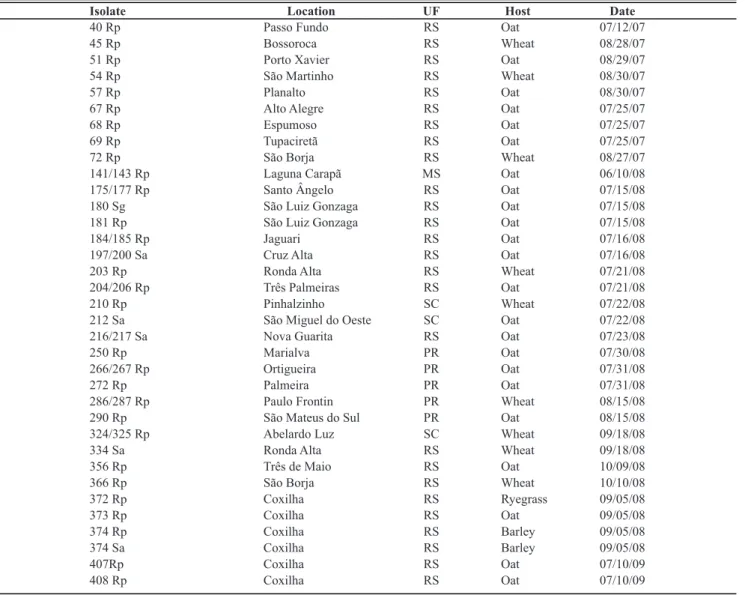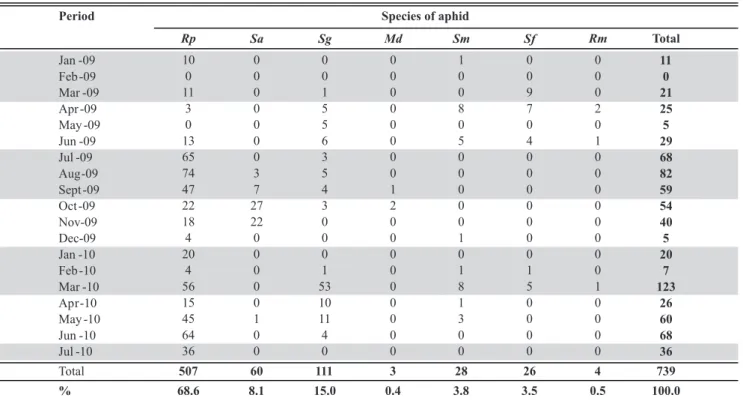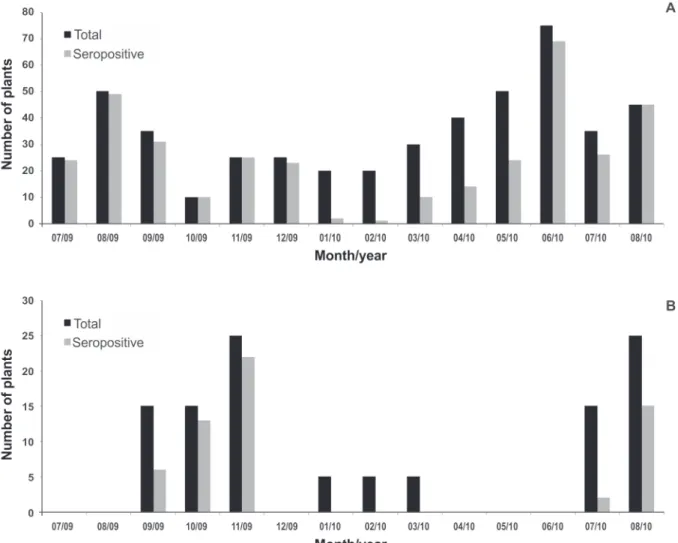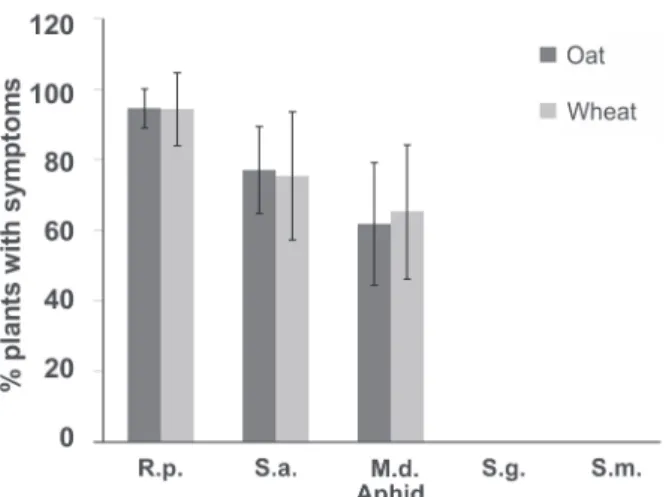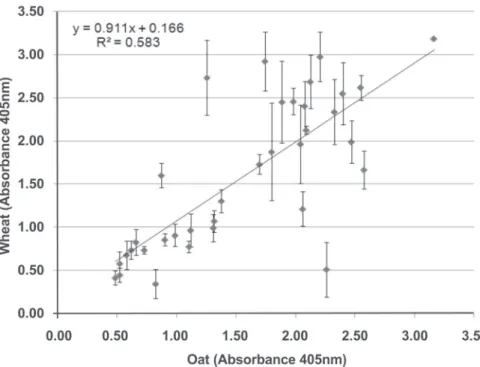RESEARCH ARTICLE / ARTIGO
Barley yellow dwarf virus
-PAV in Brazil: Seasonal fluctuation
and biological characteristics
Gabriela Parizoto1, Adriane Rebonatto1, Jurema Schons1 & Douglas Lau2
1Faculdade de Agronomia e Medicina Veterinária, Universidade de Passo Fundo, 99001-970, Passo Fundo, RS, Brazil; 2Embrapa Trigo, 99001-970, Passo Fundo, RS, Brazil
Author for corrrespondence: Jurema Schons, e-mail: schons@upf.br
ABSTRACT
The yellow dwarf disease in winter cereal crops is caused by species of Barley yellow dwarf virus (BYDV) and Cereal yellow dwarf virus (CYDV) (Luteoviridae). These viruses are transmitted to grasses (Poaceae) by aphids (Aphididae) and the frequency of virus
population is affected by oscillations in the vector and host populations. Seasonal fluctuations of BYDV-PAV, BYDV-MAV, and CYDV-RPV in aphids and grasses were analyzed in corn in the summer, and wheat and oat plots in the winter in Coxilha, RS, Brazil. Among the aphids collected, 12.7% transmitted B/CYDV, and 92.6% of those aphids were Rhopalosiphum padi while 7.4% were Sitobion avenae.
The viruses that R. padi transmitted were BYDV-PAV (95.4%), CYDV-RPV (2.3%), and BYDV-MAV+PAV (2.3%), while S. avenae only
transmitted PAV. Among the wheat and oat plants collected, 65.8% were seropositive, all of which were infected with BYDV-PAV and 0.7% of which were also infected with BYDV-MAV. The population dynamics of the virus was similar in aphids and plants, with peaks in the winter crop season. The 35 isolates of BYDV-PAV analyzed were able to infect wheat and oat, being transmitted by R. padi (EF=94.4%), S. avenae (EF=76.1%), and M. dirhodum (EF=63.4%). They were not transmitted by S. graminum or S. maydis. Since
several common vector species efficiently transmit BYDV-PAV, this may explain why it is the dominant virus species in the “yellow dwarf pathosystem” in Southern Brazil.
Key words: Luteoviridae, aphids, BYDV, CYDV.
INTRODUCTION
The yellow dwarf disease (YDD) is one of the most import virus disease of cereals worldwide. YDD is caused by virus species belonging to the family Luteoviridae.
These viruses have viral particles composed of non-enveloped isometric capsids of 25-30 nm and a viral genome composed of single-stranded, positive-sense RNA, and are transmitted by aphids (Hemiptera, Aphididae) in a circulative and non-propagative mode, hence without transovarial transmission (Miller & Rasochová, 1997; Miller et al., 2002). They are classified into two genera. The genus
Luteovirus contains the species Barley yellow dwarf virus
(BYDV): BYDV-PAV, BYDV-MAV, and BYDV-PAS; and the genus Polerovirus contains the species Cereal yellow dwarf virus (CYDV): CYDV-RPV and CYDV-RPS. The
species BYDV-SGV, BYDV-GPV, and BYDV-RMV have not yet been assigned to a genus within the family (D’Arcy & Domier, 2005).
YDD epidemics are a complex phenomenon and result from the interaction of many factors related to three components: the species of the viruses, the species of the aphids, and the species of host grasses (Irwin & Thresh, 1990). Interspecific interactions are a determinant of YDD epidemics, with the ability of these viruses to infect various plant species of the Poaceae family, whether grown as a crop
or not, and the ability to be transmitted by different species of aphid vectors playing an essential role. Transmission by aphids is such an important characteristic that it was originally a criterion for recognition and identification of the viral strains. On the basis of the specificity of the relationship between the virus species and the vector species, Rochow (1969) defined the species, being designated by the first letter of the scientific name of the main aphid vector species: BYDV-MAV (or Macrosiphum avenae virus)
is transmitted by Sitobion avenae Fabr. (=Macrosiphum avenae); BYDV-SGV (or Schizaphis graminum virus) is
transmitted by Schizaphis graminum Rond.; BYDV-PAV
(or Padi avenae virus) is transmitted by Rhopalosiphum padi L. and S. avenae; CYDV-RPV (or Rhopalosiphum padi virus) is transmitted by R. padi; and BYDV-RMV
(or Rhopalosiphum maidis virus) is transmitted by Rhophalosiphum maidis Fitch. There may be interspecific
and intraspecific variation in the patterns of transmission established by Rochow (Sadeghi et al., 1997; Gray et al., 1998; Lucio-Zavaleta et al., 2001).
indicated that the BYDV strains that occurred in Brazil in the 1970s were efficiently transmitted by Metopolophium dirhodum Walk. (the most abundant vector species at the
time) and also by S. avenae and R. padi (Caetano, 1972).
Recently there have been indications of the predominance of R. padi (Silva et al., 2004). BYDV-PAV, BYDV-MAV,
and CYDV-RPV were the main virus species detected, with the predominance of BYDV-PAV (Schons & Dalbosco, 1999; Bianchin, 2008).
The purpose of this study was to obtain data regarding the frequency of viral and vector populations in the field and to analyze biological attributes that may affect the population dynamics of the virus. Thus, the seasonal fluctuation of populations of B/CYDV was studied, and this was correlated with the predominance of vectors throughout the year. Two biological characteristics that may directly influence viral fluctuation were determined for 35 viral isolates obtained in the Brazilian production regions: the transmission efficiency of five species of aphid vectors (R. padi, S. graminum, S. avenae, Sipha maydis
Pass. and M. dirhodum), and the pathogenicity to two host
plants species, wheat (Triticum aestivum L.) and oat (Avena strigosa Schreb.).
MATERIALS AND METHODS
Monitoring of viral populations
The seasonal fluctuation of viral populations was examined in the vector population (aphids) and the host population (grasses). Surveys were made in plots established in the area of Embrapa Trigo in Coxilha, RS, Brazil. In the winter crop season (May to November), the plots were cultivated with black oat (A. strigosa), Agro
Zebu cultivar, sown in May of each year and wheat (T. aestivum), Embrapa 16, BRS Guabiju, and BRS Timbaúva
cultivars, sown in June and July. In the summer crop season (December to April), the plots were cultivated with corn (Zea mays L.).
Aphid populations were surveyed from January 2009 to July 2010, excluding February 2009, for a total of 18 months of observation. Aphid samples were randomly collected from plants every week. The aphids were transferred to oat plants (one aphid per plant at the two-leaf stage) and isolated by entomological cages (polyethylene tube, 4cm in diameter and 15cm in height, and covered with a nylon screen at the top). The transmission period was 10 days, when the plants were kept at a mean temperature of 19°C with a 12-hour photoperiod. After the transmission period, the insecticide Diclorvos was applied at a dose of 6 mL/L of water, and the plants were transferred to a screen house. Thirty days after the transmission period, plant symptoms were evaluated and samples were harvested for serological tests (TAS-ELISA) to identify the viral species.
Surveys on host populations were made from July 2009 to August 2010. Every 15 days, approximately 25 oat, wheat, or corn plants with symptoms of infection by the virus
were sampled. These plants were transplanted to 1.5 L pots with substrate and kept in a screen house. Fifteen days after transplanting, samples were harvested for serological tests (TAS-Elisa) to identify the viral species.
Serological analyses (TAS-ELISA) were performed in the Plant Virology Laboratory of the School of Agronomy and Veterinary Medicine of the Universidade de Passo Fundo (University of Passo Fundo, Passo Fundo, RS, Brazil). Antibodies from Agdia Inc. (Elkhart, USA) specific to BYDV-PAV, BYDV-MAV, and CYDV-RPV were used. Tests were conducted according to the manufacturer’s protocol, with 100 mg of leaf tissue macerated with an extraction buffer in the proportion of 100mg/mL. Absorbance at 405 nm was measured with an Anthos - Model 2010 spectrophotometer. Upon analysis of plants collected in the field, the reaction was considered positive when the absorbance value of the sample was at least two times greater than the absorbance value of the negative control (from a wheat or oat plant free of viruses) on each plate.
Biological characterization of viral isolates
Inoculum production
For each characterized isolate, multiplication of the source of the inoculum was performed separately. Acquisition of the virus reservoir plant and transmission to propagation hosts followed the procedures described above, with aviruliferous aphids being used from the species that had originally transmitted efficiently the viral isolate. The aphids remained on the fragments for a 48-hour period for the acquisition of the viral particles. After the acquisition period, the aphids were transferred individually, with the aid of a brush, to wheat or oat seedlings, according to the original host. Three pots with five plants each were used, and five aphids were placed on each plant to transmit the virus. These plants were isolated one by one with acrylic cages. The inoculation access period was 72 hours. During the acquisition and transmission period, the plants were kept in a climate-controlled chamber with a mean temperature of 19 °C and a 12-hour photoperiod. After the transmission period, the aphids were eliminated. Fifteen days after infestation with
viruliferous aphids, the viral titer of the plants was estimated by TAS-Elisa, performed per pot, gathering subsamples of leaves from the five plants of each pot. Plants from the pots with similar absorbance readings were used as viral inoculum in the transmission and pathogenicity tests so as to make the experiment as homogeneous as possible.
Determination of transmission efficiency and pathogenicity
Transmission efficiency was determined for five species of aphids: R. padi, S. avenae, S. graminum, M. dirhodum, and S. maydis. Tests were organized in a
completely randomized design. The experimental unit consisted of a pot with five plants. Three aphids per plant were used for transmission. As a control, pots of wheat and oat were maintained which received aviruliferous aphids of each species, as well as a pot of wheat and a pot of oat free of aphids. Further testing was done as described previously. Assessment of symptoms was performed visually for each
Isolate Location UF Host Date
40 Rp Passo Fundo RS Oat 07/12/07
45 Rp Bossoroca RS Wheat 08/28/07
51 Rp Porto Xavier RS Oat 08/29/07
54 Rp São Martinho RS Wheat 08/30/07
57 Rp Planalto RS Oat 08/30/07
67 Rp Alto Alegre RS Oat 07/25/07
68 Rp Espumoso RS Oat 07/25/07
69 Rp Tupaciretã RS Oat 07/25/07
72 Rp São Borja RS Wheat 08/27/07
141/143 Rp Laguna Carapã MS Oat 06/10/08
175/177 Rp Santo Ângelo RS Oat 07/15/08
180 Sg São Luiz Gonzaga RS Oat 07/15/08
181 Rp São Luiz Gonzaga RS Oat 07/15/08
184/185 Rp Jaguari RS Oat 07/16/08
197/200 Sa Cruz Alta RS Oat 07/16/08
203 Rp Ronda Alta RS Wheat 07/21/08
204/206 Rp Três Palmeiras RS Oat 07/21/08
210 Rp Pinhalzinho SC Wheat 07/22/08
212 Sa São Miguel do Oeste SC Oat 07/22/08
216/217 Sa Nova Guarita RS Oat 07/23/08
250 Rp Marialva PR Oat 07/30/08
266/267 Rp Ortigueira PR Oat 07/31/08
272 Rp Palmeira PR Oat 07/31/08
286/287 Rp Paulo Frontin PR Wheat 08/15/08
290 Rp São Mateus do Sul PR Oat 08/15/08
324/325 Rp Abelardo Luz SC Wheat 09/18/08
334 Sa Ronda Alta RS Wheat 09/18/08
356 Rp Três de Maio RS Oat 10/09/08
366 Rp São Borja RS Wheat 10/10/08
372 Rp Coxilha RS Ryegrass 09/05/08
373 Rp Coxilha RS Oat 09/05/08
374 Rp Coxilha RS Barley 09/05/08
374 Sa Coxilha RS Barley 09/05/08
407Rp Coxilha RS Oat 07/10/09
408 Rp Coxilha RS Oat 07/10/09
one of the plants at 15, 30, and 45 days after transmission. Transmission efficiency (EF) was calculated as the ratio of the number of plants showing symptoms of infection to the total number of inoculated plants.
The infection capacity of wheat and oat was estimated by TAS-ELISA 30 days after transmission. Collection was performed per pot, gathering subsamples of leaves from the five plants in each pot. The dataset related to the most efficient vector (R. padi) was used. The means of the absorbance
readings (405 nm) for each isolate of wheat and oat were compared by the t test at 5% probability.
RESULTS
Monitoring of viral populations
During the sampling period (January 2009 to July 2010), R. padi comprised 68.6% of the 739 collected
aphids, followed by S. graminum (15.0%), S. avenae
(8.1%), S. maydis (3.8%), S. flava (3.5%), R. maidis (0.5%),
and M. dirhodum (0.4%) (Table 2). Considering the three
most abundant species, R. padi occurred throughout the
entire year and was the predominant species in 14 of the 18 months. The fewest specimens of R. padi were collected
principally in the between-crop periods of the winter cereal crops. S. graminum was most frequent in the months from
March to May and S. avenae from August to November. M. dirhodum was rare, occurring only in two months
(September and October). The species S. maydis, S. flava,
and R. maidis exhibited a similar pattern of occurrence,
being less frequent during the wheat crop season (July to November).
Of the 739 collected aphids, 94 (12.7%) transmitted B/CYDV. Of these, 87 (92.6%) were R. padi and seven
(7.4%) were S. avenae. Among the viruliferous R. padi
specimens, 83 (97.7%) were carriers of BYDV-PAV, two (2.3%) carried CYDV-RPV and two (2.3%) carried BYDV-MAV and BYDV-PAV. S. avenae transmitted only
BYDV-PAV. For R. padi, the percentage of individuals that were
viruliferous was 17.2%, and for S. avenae it was 11.7%.
Throughout the 18 months sampled, these percentages ranged from 0% to 38.9% for R. padi and from 0% to
18.2% for S. avenae (Figure 1A). The peaks of viruliferous
aphids coincided with the winter cereal crop cycle (July to November 2009 and April to July 2010). A positive correlation was observed between the fluctuation of the total aphid population throughout the year and the fluctuation of viruliferous aphids. The peaks of viruliferous aphids of the two species (R. padi and S. avenae) occurred after
the total peak of these species (Figures 1B and 1C). The two specimens of R. padi with CYDV-RPV were found in
January 2009 and the two with both BYDV-PAV and MAV were found in June 2010.
Of the 625 plant collected samples, 411 (65.8%) were seropositive. Of the seropositive plants, 100% were
TABLE 2 - Total aphids per species and month of collection from plants of the experimental area located in Coxilha, RS from January
2009 to July 2010
Rp - Rhopalosiphum padi; Sa - Sitobion avenae; Sg - Schizaphis graminun; Md - Metopolophium dirhodum; Sm - Sipha maydis; Sf - Sipha flava; Rm - Rhopalosiphum maidis.
Period Species of aphid
Rp Sa Sg Md Sm Sf Rm Total
Jan -09 10 0 0 0 1 0 0 11
Feb -09 0 0 0 0 0 0 0 0
Mar -09 11 0 1 0 0 9 0 21
Apr -09 3 0 5 0 8 7 2 25
May -09 0 0 5 0 0 0 0 5
Jun -09 13 0 6 0 5 4 1 29
Jul -09 65 0 3 0 0 0 0 68
Aug -09 74 3 5 0 0 0 0 82
Sept -09 47 7 4 1 0 0 0 59
Oct -09 22 27 3 2 0 0 0 54
Nov-09 18 22 0 0 0 0 0 40
Dec-09 4 0 0 0 1 0 0 5
Jan -10 20 0 0 0 0 0 0 20
Feb -10 4 0 1 0 1 1 0 7
Mar -10 56 0 53 0 8 5 1 123
Ap r -10 15 0 10 0 1 0 0 26
May -10 45 1 11 0 3 0 0 60
Jun -10 64 0 4 0 0 0 0 68
Jul -10 36 0 0 0 0 0 0 36
Total 507 60 111 3 28 26 4 739
carriers of BYDV-PAV and three (0.7%) also contained BYDV-MAV. Of the 625 samples, 485 (77.6%) were from oat, 110 (17.6%) from wheat and 30 (4.8%) from corn. Of the oat collected plants, 353 (72.8%) were seropositive, and of these, three exhibited a mixed infection of BYDV-MAV+PAV. Of the collected wheat plants, 58 (52.7%) were carriers of BYDV-PAV. Seropositive corn plants were not found. The population of seropositive plants varied throughout the collection period (Figure 2). In the between-crop period of the winter cereals, the percentage of plants that were seropositive was only 5% in oat and 0% in wheat. In oat, the change in the percentage of seropositive plants from January to June 2010 (5% to 92%) was not attributable to changes in the number of plants collected during the year.
The population dynamics of the virus followed a similar pattern in the aphid vectors and the host plants
(Figure 3). In the between-crop period there was a concomitant reduction in the percentage of seropositive plants and of viruliferous aphids.
Biological characteristics
Transmission efficiency
R. padi, S. avenae, and M. dirhodum were able to
transmit all of the 35 evaluated isolates to wheat and oat. None of the isolates was transmitted by S. graminum or S. maydis. The isolates were most efficiently transmitted by R. padi, with the mean of transmission to oat and wheat being
94.4%, followed by S. avenae with 76.1% and M. dirhodum
with 63.4% (Figure 4).
The lowest transmission efficiency observed in R. padi was 50% for isolate 69 Rp to wheat and 75%
for isolate 374 Sa to oat. In S. avenae and M. dirhodum,
FIGURE 1 - Seasonal fluctuation of the viruliferous aphid population for species of BYDV and CYDV collected in Coxilha, RS in the
period from January 2009 to July 2010. A. Percentage of viruliferous aphids in relation to the total of individuals collected from each
species; B. Total and viruliferous R. padi specimens collected in the period; C. Total and viruliferous S. avenae specimens collected in the
FIGURE 2 - Total of plants collected and of seropositive plants for species of BYDV and CYDV (Coxilha, RS, July 2009 to August 2010). A. Oat; B. Wheat.
FIGURE 3 - Relation between the percentage of viruliferous aphids and seropositive plants for species of BYDV and CYDV collected in
FIGURE 4 - Transmission efficiency of isolates of BYDV-PAV
for five species of aphid vectors (R.p., Rhopalosiphum padi;
S.a., Sitobion avenae; M.d., Metopolophium dirhodum; S.g., Schizaphis graminum; S.m., Sipha maydis) for black oat and
wheat plants. Height of the columns corresponds to the mean value of transmission and bars correspond to ± standard deviation for n=35 isolates.
the lowest transmission efficiency was 10% to wheat for isolate 69 Rp. In addition to this isolate, S. avenae and M. dirhodum exhibited low transmission efficiencies (35% and
20%, respectively) for isolates 67 Rp and 68 Rp to wheat. To oat, the lowest transmission efficiency was 55% in S. avenae and 25% in M. dirhodum. Although there was some
variation among isolates, the majority had shown the same pattern of vector transmission; R. padi, although varying
in transmission rate, was the most effectient vector for the tested BYDV-PAV isolates, followed by S. avenae and M. dirhodum.
Pathogenicity
All the isolates were able to infect wheat and oat. The symptoms that were observed in the plants infested with viruliferous aphids, such as reddening of the leaves from the apex to the base and stiffening of the leaf blade, were similar to those observed in the field. In wheat plants, the most evident symptoms were yellowing of the leaf blade, reduction of leaf mass, and a reduced height. After 15 days, 29.7% of the oat plants and 21.3% of the wheat plants infested with viruliferous R. padi exhibited symptoms. At
30 days, the percentages reached 87.3% (oat) and 86.6% (wheat), and at 45 days it reached 94.4% (oat) and 94.3% (wheat).
The viral multiplication estimated by TAS-Elisa was similar in wheat and in oat (correlation between the readings in wheat and in oat equal to 0.764) (Figure 5). Some isolates exhibited different behavior in the two hosts. The wheat plants infected with the isolates 366 Rp; 204-206 Rp; 57 Sa; 408 Rp; and 210 Rp had a higher viral concentration than similarly infected oat plants (t test at 5%). On the other hand,
for the isolates 184-185 Rp; 216-217 Sa; 334 Sa; 72 Rp; and 69 Rp, the oat plants had a higher viral concentration than the wheat plants (t test at 5%).
DISCUSSION
Among the species of BYDV and CYDV, BYDV-PAV was the predominant, both in the vector population and the host population. In the vector population, 96% of the viruses observed were BYDV-PAV, with BYDV-MAV and CYDV-RPV at 2% each. BYDV-PAV was present in every seropositive host plant, while only 0.7% had BYDV-MAV. The viral population varied throughout the sample period. In the vector and host populations, the summer months (the period between the winter crops) were distinguished by low or zero virus levels. Peak infection levels occurred in the winter crop period when over 20% of aphids were viruliferous and nearly all plants examined were infected.
Among the aphid species that are potential transmitters of BYDV and CYDV, R. padi was the vector
species most commonly collected on plants in the period from January 2009 to July 2010 in Coxilha, RS. The second and third most abundant species were S. graminum
and S. avenae, respectively. Together, these three species
accounted for more than 90% of the aphids collected. Of all the aphids collected, 12.7% were viruliferous, and of those, 92.6% were R. padi and 7.4% were S. avenae. Viruliferous
individuals were not detected among the specimens of the other five species collected. Approximately 18% of the specimens of R. padi collected and 12% oft he S. avenae were viruliferous. The importance of R. padi and S.avenae in the YDD epidemics in Southern Brazil was
corroborated by studies of transmission efficiency under controlled conditions. Of a collection of 35 isolates of BYDV-PAV originating from Rio Grande do Sul (26), Santa Catarina (3), Parana (5), and Mato Grosso do Sul (1), all were transmitted by R. padi, S. avenae, and M. dirhodum,
with a mean transmission efficiency of 94.4%, 76.1%, and 63.4%,respectively. Just as in the field, there was no transmission by S. graminum or S. maydis.
The fact that M. dirhodum transmitted
BYDV-PAV under controlled conditions even though viruliferous individuals were not detected in the field may be attributed to the small number of individuals of this species that was collected (only three, comprising 0.4% of the total population). In Southern Brazil, the first studies of transmissibility reported the occurrence of species of BYDV transmitted by M. dirhodum, S. avenae, R. padi, R. maidis,
and S. graminum, and the strains transmitted efficiently
by M. dirhodum, S. avenae,and R. padi were dominant,
while R. maidis and S. graminum exhibited low efficiency
(Caetano, 1972).
None of the analyzed isolates of BYDV-PAV were transmitted by the population of S. graminum used in the
SGV (Johnson & Rochow, 1972); however, it has already been shown in other locations that clones of S. graminum
originating from the field are able to transmit BYDV-PAV in direct transmission tests (Gray et al., 1998).
Just as for S. graminum, positive transmission was not
obtained by S. maydis for any of the isolates analyzed in this
study and no viruliferous individuals was found in the field.
S. maydis is reported as a species capable of transmitting
viral diseases belonging to the genus Luteovirus (BYDV)
(Blackman et al., 1990). In South America, S. maydis was
first reported in Argentina, where it was shown to have the ability to transmit BYDV-PAV (Alemandri & Truol, 2009).
The relevance of other host plants, such as corn, in addition to wheat and oat in YDD epidemics in Southern Brazil needs to be better understood. In the present study, the virus was only found in these two hosts, with evidence of a multiplicative phase of the virus at the time of oat planting in the fall. In other locations, corn is the important host in the summer, acting as a green bridge to the winter crops (Henry & Dedryver, 1989).
In conclusion, by analysis of field data that show the abundance of species and viral vectors and laboratory data that indicate the transmission efficiency and capacity to infect host, it is possible to suggest R. padi as the main vector of
BYDV-PAV, due to its abundance, its presence throughout the year, and its efficiency in transmission tests. The second epidemiologically important species during the sampled period was S. avenae. BYDV-PAV, with its traits of multiple
transmission (transmission by various species of aphids) and high transmission efficiency by the most common vector species, has dominated the “yellow dwarf pathosystem in winter cereal crops” in Southern Brazil.
FIGURE 5 - Pathogenicity of
BYDV-PAV isolates to wheat (Triticum aestivum) and oat (Avena strigosa).
Points correspond to mean data of 4 replications and vertical bars correspond to ± standard deviation (abs 405nm - wheat) for the 35 isolates. r = 0.764.
ACKNOWLEDGEMENTS
The first author thanks the Coordenação de Aperfeiçoamento de Pessoal de Nível Superior - CAPES for granting a fellowship. The authors thank Embrapa and CAPES/Fapergs - Fundação de Amparo à Pesquisa do Estado do Rio Grande do Sul for financial assistance.
REFERENCES
Alemandri V, Truol G (2009) Barley yellow dwarf virus
(BYDV-PAV) y sus variantes. In: Truol G (Ed.) Enfermedades virales asociadas al cultivo de trigo en Argentina: reconocimiento, importancia, formas de transmisión y manejo. Córdoba Argentina. Instituto Nacional de Tecnologia Agropecuaria. pp. 21-26. Araya IR (1990) A review of Barley yellow dwarf virus in the
southern cone countries of South America. In: Burnett PA (Ed.). World Perspectives on Barley Yellow Dwarf. Mexico DF, Mexico. CIMMYT. pp. 29-33.
Bianchin V (2008) Ocorrência do Barley yellow dwarf virus e Cerealyellow dwarf virus, transmissibilidade do BYDV-PAV pelo
pulgão Rhopalosiphum padi e reação de cultivares de trigo ao
complexo vírus/vetor. MSc Dissertation, Universidade de Passo Fundo. Passo Fundo RS.
Blackman RL, Eastop VF, Brown PA (1990) The biology and taxonomy of the aphids transmitting Barley yellow dwarf virus.
In:Burnett PA (Ed.). World Perspectives on Barley Yellow Dwarf.
Mexico DF, Mexico.CIMMYT. pp.197-214.
Caetano VR (1968) Nota prévia sobre a ocorrência de uma virose em cereais de inverno no Rio Grande do Sul. Revista da Sociedade Brasileira de Fitopatologia 2:53-66.
cevada, em trigo, no Rio Grande do Sul. DS Thesis, ESALQ-USP. Piracicaba SP.
D’Arcy CJ, Domier LL (2005). Family Luteoviridae. In: Fauquet
CM, Mayo MA, Maniloff J, Desselberger U, Ball LA (Eds.) Virus Taxonomy. VIIIth Report of International Committee on Taxonomy of Viruses. London UK. Elsevier Academic Press. pp. 891-900.
Gray S, Chapin JW, Smith DM, Banerjee N, Thomas JS (1998)
Barley yellow dwarf luteoviruses and their predominant aphid
vectors in winter wheat grown in South Carolina. Plant Disease 82:1328-1333.
Henry M, Dedryver CA (1989) Fluctuations in cereals aphid populations on maize (Zea mays) in eastern France in relation to
the epidemiology of Barley yellow dwarf virus (BYDV). Journal
of Applied Entomology, 107:401-410.
Irwin ME, Thresh JM (1990). Epidemiology of barley yellow dwarf: a study in ecological complexity. Annual Review of Phytopathology 28:393-424.
Johnson RA, Rochow WF (1972) An isolate of Barley yellow dwarf virus transmitted specifically by Schizaphis graminum.
Phytopathology 62:921-925.
TPP 470 - Received 2 January 2012 - Accepted 24 September 2012 Section Editor: Alice K. Inoue-Nagata
Lucio-Zavaleta E, Smith DM, Gray SM (2001). Variation in transmission efficiency among Barley yellow dwarf virus-RMV
isolates and clones of the normally inefficient aphid vector,
Rhopalosiphum padi. Phytopathology 91:792-796.
Miller WA, Rasochová L (1997) Barley yellow dwarf viruses. Annual Review of Phytopathology 35:167-190.
Miller WA, Beckett R, Liu S (2002) Structure, function and variation of the Barley yellow dwarf virus and Cereal yellow dwarf virus genomes. In: Henry M, McNab A (Eds.). Barley Yellow
Dwarf Disease: Recent Advances and Future Strategies. Mexico DF, Mexico. CIMMYT. pp. 1-8.
Rochow W F (1969) Biological properties of four isolates of
Barley yellow dwarf virus. Phytopathology 59:1580-1589.
Sadeghi E, Dedryver CA, Gauthier, JP (1997) Role of acquisition and inoculation time in the expression of clonal variation for BYDV-PAV transmission in the aphid species Rhopalosiphum padi. Plant Pathology 46:502-508.
